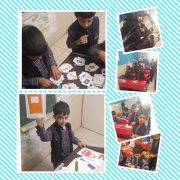Newsletter- Bahman & Esfand
Dear parents:
You are kindly informed that in our English class these subjects have been covered in 2 months. (Bahman & Esfand)
| Skills | Contents |
| Reading | · Reading and understanding a cultural text about weather
· Reading and understanding a personalization text · Understanding information in sentences and short texts · Anticipating the content of a text · Reading a text and identifying specific information · Understanding general and specific information in a story · Understanding specific information about after-school activities in other countries |
| Writing | · Writing about the activities the characters are doing
· Answering questions about actions · Completing answers with the words provided · Transferring information from a text to make sentences · Writing about favourite actions. |
| Listening | · Understanding undersand responding to questions
· Understanding a story · Identifying actions in recordings · Understanding what other are doing at the moment · Understanding specific information in a song about current actions · Understanding information in a recorded conversation to ask and answer questions · Understanding specific information about after-school activities in other countries |
| Speaking | · Suggesting activities for different weather types
· Acting out a story · Describing temperature · Describing weather in one’s own countries · Repeating words and sentences · Chanting and singing · Giving information about actions they are doing at the moment of speaking · Pronouncing ai and ee correctly · Reporting about what others are doing |
| Vocabularies |
| · Verbs 1: get up, go to bed, go to school, go home, have breakfast, have lunch, have dinner.
· Verbs 2: eat fruit, drink milk, do my homework, listen to music, play the piano, sing, talk on the phone, tidy. · Telling the time: o’clock, half past. · Adverbs of frequency: always, sometimes, never. |
| Structures |
| · At + time= He (gets up) at (half past seven)
· I always (go to bed) at eight o’clock. · I never (listen to music). · I sometimes (play the piano). · I ( do my homework) every day. |
| Science |
| · Plants and trees
· Different parts of the plant · Foods and materials that plants give us · What plants need to grow · Sources of light · How shadows are made · Which objects float on or sink in water |
| Math |
| · Reading time
· Drawing the time and showing it on a clock · Telling the time: o’clock, half past. |
والدین محترم
احتراماً به اطلاع میرساند مطالب ذیل طی دو ماه بهمن و اسفند در کلاس زبان کار شده است.
| کلمات |
| · کلمات مربوط به فعالیت های مختلف
· کلمات مربوط به ساعت · قیود تکرار |
| دستور زبان |
| · At + time= He (gets up) at (half past seven)
· I always (go to bed) at eight o’clock. · I never (listen to music). · I sometimes (play the piano). · I ( do my homework) every day. |
| علوم |
| · گیاهان و درختان
· قسمتهای مختلف گیاه · نیازهای گیاهان · منایع نور · چگونگی بوجود آمدن سایه · شناور بودن یا فرو رفتن اجسام در آب |
| ریاضی |
| · آشنایی با ساعت
· چگونگی نوشتن و کشیدن ساعت |

